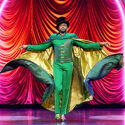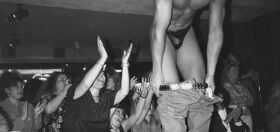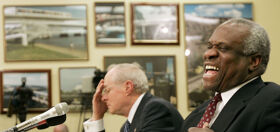
To be fair, activist David Mixner — one of the original backers of a march on Washington this fall — has a pre-existing engagement in Africa that may keep him from attending October 11’s National Equality March. Also to be fair, Mixner (pictured, below) originally wanted a march in November … so he could attend. But then Cleve Jones & Co. took the reins on the project, pushed it to National Coming Out Day, and now has about two months to pull the whole thing together. Steve Ault, who coordinated the first National March on Washington for Lesbian & Gay Rights in 1979, sees a big problem with this.
Having witnessed the success of democratically-organized marches in the past, Ault only sees trouble with how things are being handled for this October’s March. For all this pomp and circumstance about how organizers are grassroots-ing it, they’re really closed door-ing it.
He writes in Gay City News:
To date there have been four national marches on Washington organized by the LGBT community — in 1979, 1987, 1993, and 2000. The first three were great successes; the fourth a fiasco marked by a huge event-day rip-off of participating small business people, followed by bankruptcy, lawsuits, and an FBI investigation — not to mention a turnout a mere fraction of the 1987 and 1993 marches.
By no coincidence, the first three were run democratically, with grassroots involvement in decision-making and organizing; the fourth — the grandiosely named “Millennium March” — had self-selected leadership and a decision-making process closed to the community.
Briefly, here’s how our first three marches were organized and structured. The primary decision-making steering committee, national in scope, was comprised of delegates elected at regional meetings, assuring representation from all parts of the country while also mandating gender parity and inclusion of people of color. National organizations and spokespeople from unrepresented and underrepresented constituencies were added to make sure just about everyone had a seat at the table. The leadership was in turn elected from and by the steering committee. This decision-making process — admittedly contentious and chaotic at times — won acceptance as fair and inclusive. The ability to be both heard and represented motivated people from all over the country to commit time, energy, and resources to building these marches — a factor at the very heart of their success.
So how is that different from this year’s march? Besides Dustin Lance Black joining the steering group?
How about we take this to the next level?
Our newsletter is like a refreshing cocktail (or mocktail) of LGBTQ+ entertainment and pop culture, served up with a side of eye-candy.

I checked out David Mixner’s website where the “National Equality March” was announced, ostensibly for and by the LGBT community, although the name of the event was devoid of any such reference. The date was set, as was an overarching statement of purpose, but unlike the earlier actions, there would be no specific demands.
Despite rhetoric invoking the “grassroots,” it appears the leadership already had been decided: Mixner, and a few self-selected others. The whole package was signed, sealed, very neatly wrapped, and then delivered to the LGBT community as a fait accompli.
To be sure:
That’s not to say a future march must be organized exactly the same way in order to succeed. We should, of course, take full advantage of the many new social networking technologies available to connect us with each other. But these technologies cannot replace what is unique about face-to-face meetings and old-fashioned grassroots organizing — experiences crucial to building and sustaining a sense of community.



















hardmannyc
This is such a waste of resources. The Prop8 demonstrations proved that ground-up local activism is where it’s at in the 00s .
Brian
$250 million – IMPORTANT MATH:
If 500,000 gay people travel to Washington D.C. for this so-called March they will each spend $500 (or more). This is $250 million, near the Amount Obama spent on advertising for the Presidential Election and we will get MAYBE A MENTION ON THE EVENING NEWS???
If (big IF) there was $250 million in financial resources (Cleve hopes will be wasted in a single day)can’t we think of something BETTER to do with that kind of money?
This is 2009 and we live in a different world. Where are the bright young minds with big ideas? Surely we can do better than a non-effective “March” on Washington.
Queerty – why not start some type of competition for “new ideas?” New GAY ideas. Many of us want to do something, but marching around is so 1980-ish lame.
Andrew
I guess the number of comments on this story is telling – we don’t need to March, we need a strategy. We need to think about winning, not demanding or surviving. We need some clear direction.
I sincerely hope people will not waste their time and money on this March. It won’t change anything.
Joe
Brian and Andrew, you guys are right. If we want to accomplish something, discouraging people from participating in public action is definitely the way to go! I sincerely hope more people will sit at their computers and shoot down activism efforts instead of going out and, you know, participating. That’s how to really change things.
Andrew
@Joe: Maybe you can tell us how “marching around Washington” actually changes anything? Participating in what, exactly? Gathering as a crowd and “demanding” respect, fairness and rights?
Tell Cleve Jones and the other old farts that the World has changed. There is a very vibrant community “online” that many of us participate in by TRYING TO CHANGE MINDS. It is a “conversation” and it has a chance of making a difference. This doesn’t mean that people wouldn’t march – it just isn’t something that’s planned, it’s best use is “reactionary.”
Finally – if 500,000 gay people go to Washington D.C. to colorfully march around, they will spend about $500 each – that’s $250 million. Aside from the self-promotion of a few “gay-rights-pimps” I haven’t heard ANY explanation of ANY “benefits” we’d receive for the $250 million investment.
The National Equality March has no compelling idea, strategy or plan – if they did, it might make sense. Therefore, it is a shockingly obvious waste of time, energy AND (gay) money.
threshold
I attend uni in the capital so I might show up, but the money would be better spent on the upcoming gay marriage referendum in Maine.
youcanthandlethetruth
When it comes to changing minds in DC or elsewhere these protests are complete waste of time. They only serve to make th eparticipants feel better and enjoy a day out.
If you get 20 seconds on the news you will be lucky.
Andrew
It is now “on the verge of being cancelled.”
M Shane
I sincerely believe that demonstrations in many situations do make a difference. Citizens of the U.S. are generally pretty apathetic about much of anything. Of course that is wy the government can literally pull a coup if they wanted to As Bush/Cheney came so sickeningly close to.
If it had not been for the rampant and vigorous protests against the Veitnam War it could have gone on for god knows how long.
This case seems to be an exception, for several reasons. (1) there is not a generally understood or popular cause against what is a clear outrage. We don’t even know yet what the government is going to do–it is to early to know.
(2) as far a marriage goes: because of the overwhelming Christian fanaticism in this country, it is doubtful that there will be any more that a bill legalizing some kind of Civil Unions.
(3) as far as the Military goes -who knows- – gay people let that by then prima facia immorality-it tells people to lie about who they are.
Any Gay platform or sense of unity has been determined aklmost solely by a few right wing idiot journalists; namely Andrew Sullivan and Bruce Bawer and right wing supporters
Until the gay populous developes some idea that their future will depend on building al liances with other marginalized groups and caring about something besides slipping into the safety of being mainstreamed (closeted),
there is no chance of having any clear cayuse that others can support.
The reality about things like marriage is that not all gay people care about it at all.
I think that we should do all we can to demonstrate when and where we will be heard. The issue we have are certainly not of the sort that cause people to immolate themselves, so people have to hold on to and speak for what they want.even if there is strong opposition. We are a minority and when everyone can accept who they are, and develope a way to live on those terms , nothing else will haoppen accept that we will make the crayzoids crazyier.
Brian
It is being cancelled. They may try to change it to “training for Activists.” I hope Cleve is making refunds.
Brian
They are NOT making refunds. My friend donated $10,000 and he heard this morning “the money was spent.” I donated a lot less, but it is clear we got NOTHING from this charade.